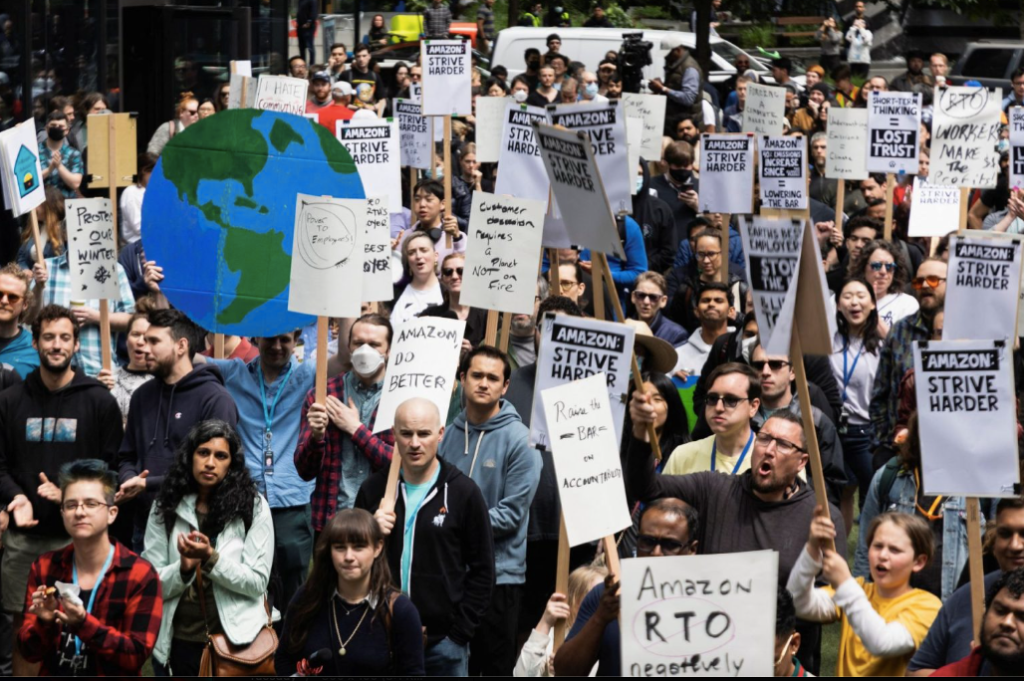|
Getting your Trinity Audio player ready...
|
In a striking display of dissent, Amazon corporate workers participated in a walkout on Wednesday, expressing their “lack of trust” in the company’s leadership. The event, organized by the Amazon Employees for Climate Justice and a remote work advocacy group, saw more than 1,000 corporate employees gather in person at Amazon’s Seattle headquarters, with virtual participation from other corporate offices.
Organizers had initially claimed that over 1,800 Amazon employees committed to joining the walkout, intending to highlight employee frustrations on various fronts, including the company’s push for employees to return to the office at least three days a week. However, Amazon disputed the figure, stating that approximately 300 people participated in the event.
Eliza Pan, a former Amazon worker, and co-founder of the Amazon Employees for Climate Justice group, addressed the crowd, emphasizing that many Amazonians feel that something is amiss within the company. She cited the rigid and uniform return-to-office mandate as one of the signs that something is not right. The walkout aimed to raise two main demands: prioritizing climate impact in decision-making and providing greater flexibility in how and where employees work.
The protest comes when Amazon, along with other Big Tech companies, has undergone significant job cuts due to economic uncertainties. Despite these layoffs, the company has been pushing for more in-office attendance. Amazon announced in February that thousands of its workers would be required to be in the office at least three days per week, starting on May 1.
Morale among Amazon corporate workers appears to be at an all-time low, with employees expressing dissatisfaction and concerns about the new return-to-office policy. The walkout was an outlet for these frustrations, with participants voicing their discontent and advocating for remote work options.
In response to the walkout, Amazon acknowledged that it may take time for some workers to adjust to increased office attendance but stated that the company is committed to making the transition as smooth as possible. Brad Glasser, an Amazon spokesperson, highlighted the positive aspects of having more employees back in the office, citing increased energy, collaboration, and connections.
Amazon Employees for Climate Justice, the same coalition that organized protests against the company’s inaction on climate change in 2019, spearheaded the walkout. The group called on Amazon to keep pace with a changing world, emphasizing the need for concrete plans to address the company’s climate impact and provide flexible work options. While Amazon has committed to reaching net-zero carbon emissions by 2040 through its Climate Pledge, the group criticized the pledge as “hype” and demanded a genuine climate plan.
Amazon defended its efforts, stating that it is working towards achieving its climate goals and has garnered the support of over 400 companies in its Climate Pledge. However, the company acknowledged that the transition would take time, particularly due to its substantial power consumption, transportation, packaging, and physical assets.
The walkout serves as a visible demonstration of employee dissatisfaction and highlights the ongoing tension between Amazon’s leadership and its workforce. The outcome of this protest could potentially influence the company’s approach to employee concerns and the future of its work policies.
The walkout by Amazon corporate workers represents a significant moment for the e-commerce giant, as it showcases the growing discontent among its office employees. With over 1,000 participants taking a stand, it sends a clear message that workers are demanding a change in leadership and a reevaluation of company policies.
The event organized by the Amazon Employees for Climate Justice and the remote work advocacy group demonstrates the importance of employee voices in shaping the future of the company. The walkout’s focus on climate impact and work flexibility reflects the shifting priorities of workers who want Amazon to align with the changing needs of the world and provide sustainable solutions.
This protest comes in the wake of widespread job cuts at Amazon and other tech companies, raising concerns about the balance between downsizing and pushing for increased in-office presence. As employees face uncertain times, the mandate to return to the office three days a week has further dampened morale and fueled frustrations.
The walkout served as a platform for employees to express their dissatisfaction openly. Voices like Eliza Pan and Pamela, who addressed the crowd, shared personal experiences, and rallied support for a more inclusive and adaptable work environment. The overwhelming response to the internal Slack channel “remote advocacy” underscores the significance of employee solidarity in challenging company policies.
Amazon’s response to the walkout acknowledges the need for an adjustment period but emphasizes the positive outcomes observed during the initial month of increased office presence. The company’s commitment to listening to employee concerns and striving for a smoother transition indicates a willingness to address the issues raised during the protest.
Amazon Employees for Climate Justice, known for their previous activism, continue to advocate for concrete action on climate change, urging the company to go beyond its current commitments. The clash between the group’s demands and Amazon’s ongoing efforts to reduce its carbon footprint highlights the ongoing tension between corporate responsibility and the urgency for immediate change.
The repercussions of this walkout extend beyond Amazon’s immediate response. It serves as a powerful reminder that employee voices can no longer be ignored or dismissed. As workers push for more equitable and sustainable practices, companies like Amazon must recognize the importance of employee satisfaction, well-being, and meaningful engagement.
The outcome of this protest will likely shape the future direction of Amazon’s work policies and corporate culture. As employees stand united, demanding transparency, flexibility, and a genuine commitment to addressing climate impact, the ball is now in Amazon‘s court to listen, engage, and take meaningful action. The walkout stands as a testament to the power of employee activism and the potential for positive change within one of the world’s largest corporations.
